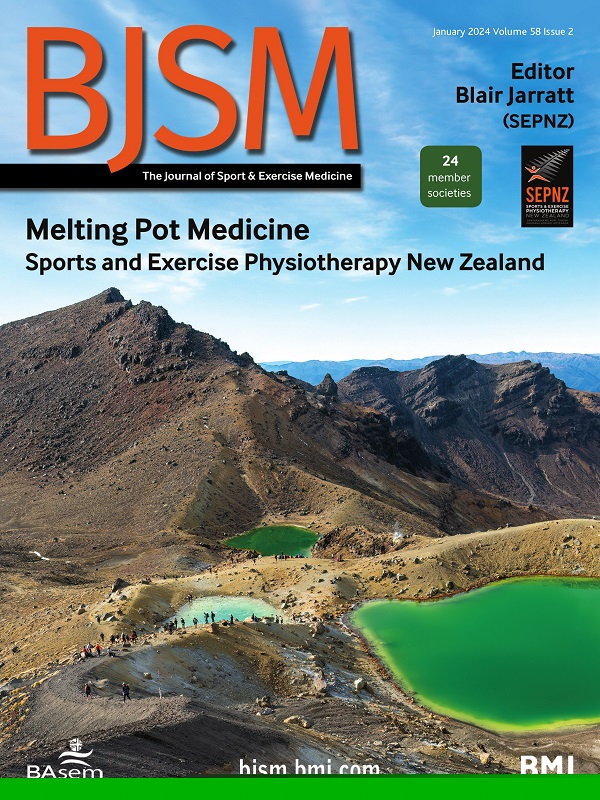Effect of intravenous iron therapy on exercise performance, fatigue scores and mood states in iron-deficient recreationally active females of reproductive age: a double-blind, randomised control trial (IRONWOMAN Trial)
IF 11.6
1区 医学
Q1 SPORT SCIENCES
引用次数: 0
Abstract
Objectives Non-anaemic iron deficiency (IDNA) is highly prevalent in exercising females. Although iron therapy can be used to correct this issue, its impact on exercise performance is equivocal. Our aim was to assess the efficacy of intravenous iron therapy on exercise performance, fatigue, mood states, and quality of life in recreationally active IDNA females of reproductive age. Methods Twenty-six recreationally active IDNA females were randomised to either an intravenous iron treatment (IRON) group or placebo (PLA). Prior to, 4 days and 4 weeks following intervention, participants completed a variety of assessments to determine changes in exercise performance, haemoglobin mass, blood iron status and haematology, fatigue levels, mood states and quality of life. Results Intravenous iron therapy significantly improved serum ferritin, serum iron and transferrin saturation (p<0.05), with a highly variable individual response. No differences were observed between groups’ peak oxygen consumption (V̇O2Peak), lactate threshold or haemoglobin mass. Running economy improved in IRON from baseline to 4 weeks (p<0.05), which was also different to PLA at 4 weeks (p<0.05). Fatigue scores improved in IRON but not PLA after 4 weeks (p<0.05). Mood states and quality of life remained unchanged in both groups over the trial. Conclusion In recreationally active IDNA females, intravenous iron therapy corrects iron status and improves both exercise economy and fatigue scores after 4 weeks. Trial registration number ACTRN12620001357943. Data are available upon reasonable request. To adhere to ICMJE guidelines, a data sharing plan is included with trial registration (ACTRN12620001357943). Data will be made available following the published date for the purposes of generating empirical knowledge through research collaboration, for example, systematic reviews and meta-analyses (inclusive of individual patient data meta-analyses). Requests to obtain data can be made by emailing the principal investigator (cory.dugan@research.uwa.edu.au).静脉铁治疗对缺乏铁的育龄女性运动表现、疲劳评分和情绪状态的影响:一项双盲、随机对照试验(IRONWOMAN试验)
目的非贫血性铁缺乏症(IDNA)在运动女性中非常普遍。虽然铁疗法可以用来纠正这个问题,但它对运动表现的影响是模棱两可的。我们的目的是评估静脉注射铁治疗对娱乐性dna活跃的育龄女性运动表现、疲劳、情绪状态和生活质量的影响。方法将26名娱乐性IDNA活跃的女性随机分为静脉铁治疗组(iron)和安慰剂组(PLA)。在干预前、干预后4天和干预后4周,参与者完成了各种评估,以确定运动表现、血红蛋白含量、血铁状态和血液学、疲劳水平、情绪状态和生活质量的变化。结果静脉铁治疗显著改善血清铁蛋白、血清铁和转铁蛋白饱和度(p<0.05),个体反应差异较大。两组间耗氧量峰值(V O2Peak)、乳酸阈值和血红蛋白质量均无差异。从基线到第4周,IRON组的跑步经济性有所改善(p<0.05),与第4周的PLA组相比也有所不同(p<0.05)。4周后,IRON组的疲劳评分有所改善,PLA组的疲劳评分无明显改善(p<0.05)。在整个试验过程中,两组患者的情绪状态和生活质量保持不变。结论在娱乐性活跃的IDNA女性中,静脉注射铁治疗可以纠正铁状态,并在4周后改善运动经济性和疲劳评分。试验注册号ACTRN12620001357943。如有合理要求,可提供资料。为了遵守ICMJE指南,试验注册中包含数据共享计划(ACTRN12620001357943)。数据将在发表日期之后提供,目的是通过研究合作产生经验知识,例如,系统评价和荟萃分析(包括个体患者数据荟萃分析)。获取数据的请求可以通过电子邮件发送给主要研究者(cory.dugan@research.uwa.edu.au)。
本文章由计算机程序翻译,如有差异,请以英文原文为准。
求助全文
约1分钟内获得全文
求助全文
来源期刊
CiteScore
27.10
自引率
4.90%
发文量
217
审稿时长
3-8 weeks
期刊介绍:
The British Journal of Sports Medicine (BJSM) is a dynamic platform that presents groundbreaking research, thought-provoking reviews, and meaningful discussions on sport and exercise medicine. Our focus encompasses various clinically-relevant aspects such as physiotherapy, physical therapy, and rehabilitation. With an aim to foster innovation, education, and knowledge translation, we strive to bridge the gap between research and practical implementation in the field. Our multi-media approach, including web, print, video, and audio resources, along with our active presence on social media, connects a global community of healthcare professionals dedicated to treating active individuals.

 求助内容:
求助内容: 应助结果提醒方式:
应助结果提醒方式:


